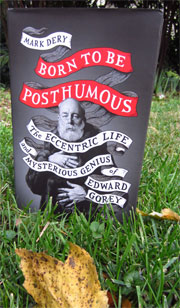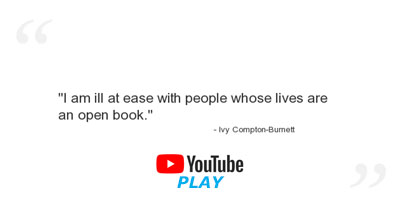Goreyography
Interviews
An Interview with Mark Dery, author of
BORN TO BE
POSTHUMOUS
The Eccentric Life and Mysterious Genius of
Edward Gorey
Interviews
An Interview with Mark Dery, author of
BORN TO BE
POSTHUMOUS
The Eccentric Life and Mysterious Genius of
Edward Gorey


Born to be Posthumous;
The Eccentric Life and Mysterious Genius of
Edward Gorey
by Mark Dery
Little, Brown & Co., New York
ISBN 978-0316188548
hardcover, 512 pages
$35
available paperless for $16.99
from Little, Brown & Co
The Edward Gorey House,
or from Amazon.com
Reviewed
31 October 2018
by Glen Emil,
Goreyography
Interviewed November 7-11, 2018
|
As I'm writing this, the mailman pushes a bunch of soggy envelopes and catalogs through the mail slot in the front door. There's a small catalog with a large, familiar illustration of a smiling Gorey feline, his alter ego wrapped in an outrageously long Harvard scarf. The Sunday Washington Post publishes a rather large Doubtful Guest illlustration in their review of Mark Dery's new book, Born to be Posthumous. When I shop Amazon, Born to be Posthumous is the #1 New Release in the Art History and Author's Biographies categories. The Edward Gorey House museum is listed as the #1 destination for '8 things to do in Cape Cod' when I visited TripAdvisor the other day. YouTube has a nearly never-ending selection of fan videos of Gorey-inspired works, from around the world. Edward Gorey is all around.
Very satisfying, yet part of me wants always to find Edward Gorey lurking in the fringes. It's part of what drew me to his works - those intimately discrete, instantly recognizable, deceptively simple objects, barely books at all, and not for everyone. When visiting someone's house, I used to try to locate their bookshelf, closet, or block 'n board. Gorey books are easy to spot among other books, and they're usually kept huddled together. Finding a Gorey deposit instantly made any dwelling a well-endowed home, and a cultural safehaven. Fast-forward a few decades, we find Edward Gorey peeking out of every corner. A real commercial success. First announced in Publisher's Weekly in 2010, Mark Dery delivered his promised biography seven years later. Possessing a sharp eye for hunting zeitgeists in modern American culture, Mr. Dery set his sights on Edward Gorey, who to his surprise, was often summarily portrayed by a collection of disparate vignettes: a childhood prodigy who read Dracula by seven, hadn't missed a single performance of Balanchine's choreography for entire seasons at the New York City Ballet, served in W.W.II at a U.S. Army poison gas test facility in Utah, awarded a Tony for costume design - not the stage sets, for Broadway's Dracula and lived alone, with six cats in Cape Cod. That seemed to be it. Well-worn snippets with a few B&W portraits. 
In one fell swoop, with Little, Brown & Co's publication of Born to be Posthumous; The Eccentric Life and Mysterious Genius of Edward Gorey, Mark Dery managed to nudge Gorey back towards the fringes of society, by presenting an eccentric Mr. Gorey, drifting among his milieu, and showing just how mysterious, passionate and eclectic our favorite author & illustrator had been. By uncovering so much more detail, Dery's unauthorized biography shows just how singular and complex Gorey's life seemed to be, and how entertaining it might have been, to have his acquaintance. Not unlike Edward Gorey's grand entrance into Harvard in his first year in 1946, Born to be Posthumous seems to be making a bit of a splash in the literary world. We were naturally very pleased that Mr. Dery took time to entertain a few questions about his latest book: GOREYOGRAPHY: Born to be Posthumous (again, BTBP hereafter) is a nicely-woven chronicle, a pleasure to read. The timing was good too, as it ties together some of the other literary works exploring separate aspects of Gorey's legacy in recent years. How do you feel about Gorey after completing the book? How did you feel about Gorey before writing BTBP? MARK DERY: Happy to hear you enjoyed my ramble through the West Wing of Gorey's psyche. As for my feelings about Gorey before and after, the Alexander Theroux book (The Strange Case of Edward Gorey) had given me an inkling that Gorey was more than just a floor-length fur coat, a pair of grimy sneakers, and that Victorian beard. From the interview collection, Ascending Peculiarity, I got a sense of the man in full, in all his deliciously idiosyncratic Goreyiness - the Wildean persona and the silent-movie histrionics; the inexhaustible opinions and mic-dropping zingers on everything under the sun; the obscure passions, undying obsessions, and implacable detestations (of Henry James, famously, but also of a thousand other things, from Kathie Lee Gifford to Richard Nixon to turnips to "movies about ea-ting," as he told Theroux in "a malicious lilt, 'like My Dinner with Andre´ and Like Water for Chocolate'"). That said, I went into this not knowing the half of it, which is the case for most biographers, I imagine, and is what makes biographizing-is that a word?-part Agatha Christie mystery, part Freudian psychoanalysis, part time travel, part archaeological dig, sometimes fruitful, sometimes pointless exploration of the hedge maze of someone else's life and mind. 
Before writing Born to be Posthumous, I was so smitten by Gorey's persona that I couldn't really make out the man behind the collection of quirks. Now that I've spent seven-plus years doing a deep dive into his childhood, the Chicago he grew up in, his Harvard days, his New York years, his ballet circle and the clique of cinephiles he went to the movies with, his Cape Cod theatrical troupe, and all the rest of it, I feel as if I've illuminated some of the shadowy corners of his personality and cast some light on the deeper meanings of his work. At the same time, I was at pains, in writing the story of Gorey's life, to allow him the irresolvable mysteries that made him so...Goreyesque. Did I come to know him? Do we ever really know anyone? Gorey's a riddle that can't be unriddled. Perhaps that's what I came to love best about him. That, and the fact that he was utterly unique in a world where so many of us choose from a limited menu of lives to lead, people to be. Oscar Wilde, an influence both on Gorey's arch quips and on his Victorian aesthete-meets-preppie-beatnik persona, nailed it when he said, in "De Profundis," "Most people are other people. Their thoughts are some one else's opinions, their lives a mimicry, their passions a quotation." Gorey was a species of one. GOREYO: You uncovered some new names who were very important to Gorey in terms of personal relationships, an area not widely explored in other writings. Were there any subjects in Gorey's life you wished you had more time to explore, or people you wanted to contact? DERY: Given unlimited time and inexhaustible funds, I would've visited the islands off Scotland's west coast - the Outer Hebrides, the Orkneys, the Shetlands, Fair Isle - that Gorey made a pilgrimage to, inspired by his passion for the Powell and Pressburger film, I Know Where I'm Going. I visited them in my mind, with the aid of books and the Web, but I do wish I'd been able to stand on their moors and walk the sea-pounded beaches of those hauntingly lonely hunks of wind-whitled rock, not only because they spoke to Gorey but also because they speak to the "Celtic twilight" (Yeats's phrase, which Gorey used) in me, too, as someone of Irish-English-Scottish mongrel stock. As for interview subjects, I bagged all the big game, some of whom are no longer with us, except Andreas Brown, who from what I gather declines to speak with biographers who aren't officially appointed to the Court of Gorey. Mine was very much an unauthorized biography, happily; I wouldn't have it any other way, since Authorized Biographer is just a nice name for hagiographer. 
GOREYO: Yes, it seems previous biographical essays on Gorey tended to explore 'safe areas', and had become predictable over the years, I always assumed for lack of new material. I too had read the unpublished phone transcripts between Maurice Sendak and Kevin Shortsleeve, and found Sendak's 'moment of truth' fascinating, that his 'coming out' of the closet being coaxed out in a public forum, and he did so spontaneously, at moment's realization. Gorey had already begrudgingly acknowledged his 'identity' as gay in a magazine interview in 1980, so it was curious that popular media still portrayed Gorey as mysteriously 'asexual'. While reading BTBP, I felt you were giving voice to a movement to posthumously re-cast Gorey as sexually closeted. Or, perhaps you were laying a more direct path, a more sympathetic guided tour for the reader, to some other conclusion? DERY: Fascinating. That hadn't occurred to me but I love your interpretation of this passage. I hope it casts that very spell. There was a terrible melancholy, I thought, to Sendak's wistful musings about what he perceived as Ted's closeted gayness, and his wish that Gorey, too, might have found the escape hatch he [Sendak] did. I'm not going to spoil the book for your readers but I will say that we can, if we prefer, read Gorey's sexuality as a question mark. Whether he was closeted or truly asexual as he often suggested may be unknownable. So, too, we may never know how unhappy that made him - or whether it did at all, or whether, in his only-child, lifelong-solitary, catlike way he agreed with the poet Andrew Marvell that "Society is all but rude,/ To this delicious solitude." GOREYO: You are obviously well acquainted with Gorey's works. Which do you find particularly appealing? DERY: Original Gorey art is, sadly, far beyond my means as an ink-stained wretch, but Gorey's Doubleday Anchor paperbacks weren't too pricey or too hard to find when I started writing the book in 2011, so I began hunting them down - purely for research purposes, I told myself. Of course I was hooked before I knew it, and now own a few dozen. I'm not obsessive about it - or assiduous - but I could easily become a compulsive completist if I don't watch out! There's something so juicy about the size and thickness of these little books; it stirs some kind of infantile, Freudian orality in those of us with the collector's gene, and never fails to remind me of a story Maurice Sendak loved to tell, about a little boy who wrote him to say how much he liked Sendak's books. The boy's highest praise was: "I want to bite them." I know just what he means. Of course, there's also Gorey's incomparable covers, especially his pitch-perfect tonal palette, those emotionally ambiguous, vaguely unsettling, deliciously icky lavenders and lemon-yellows and "three different shades of blah gray-olive," as he put it. GOREYO: Yes, I think its Travels in Arabia Deserta by Doughty has that unreal yellowy-olive green cover, one of my favorites as well. This project was obviously a labor of love. Do you have other such projects around the corner? DERY: Not at the moment. Merciful Minerva, man, I'm still recovering from seven-odd years of heavy mental lifting! For the moment, I'm like the little "boy of German parentage" in Tom Sawyer's Sunday school who dazzled the schoolmaster by reciting from memory "three thousand [Bible] verses without stopping; but the strain upon his mental faculties was too great, and he was little better than an idiot from that day forth." . . . (Mark Dery, author of Born to be Posthumous, in a series of emails to Glen Emil @ Goreyography from November 7-11, 2018) Future generations can now better understand the world that Edward Gorey inhabited, or at least have some semblance of how he lived his life. Not so much what was spurring his art and writing, but what was happening within arms reach. Context, in a word. Born to be Posthumous provides a new familiarity into Gorey's existence. As to what Gorey was conveying in his books and art? After all, his own theory "...that anything that is art...is presumably about some certain thing, but is really always about something else...' is so true, and must also apply to his own work. I'd say Gorey was trying to entertain himself while making a living, and like all artists, tries to create emotions by turning what was inside, out, in the best way he knew how. -- Glen Emil Goreyography November 28, 2018 
About the Author Mark Dery is a cultural critic. He coined the term "Afrofuturism", popularized the concept of "culture jamming", taught at Yale and NYU, and has published widely on pop culture, the media, and on the mythologies (and pathologies) of American life. His books include Flame Wars, a seminal anthology of writings on digital culture; Escape Velocity: Cyberculture at the End of the Century, The Pyrotechnic Insanitarium: American Culture on the Brink, and the essay collection, I Must Not Think Bad Thoughts: Drive-by Essays on American Dread, American Dreams. Like Gorey, his mission in life "is to make everybody as uneasy as possible." -- from Little, Brown & Co. Visit his website at www.markdery.com. You can listen to Mark Dery talk about writing his book in a live interview by Gil Roth @ The Virtual Memory Show on YouTube. Many thanks to Mark Dery for his generous time. |
Book photograph by Goreyography, © 2018